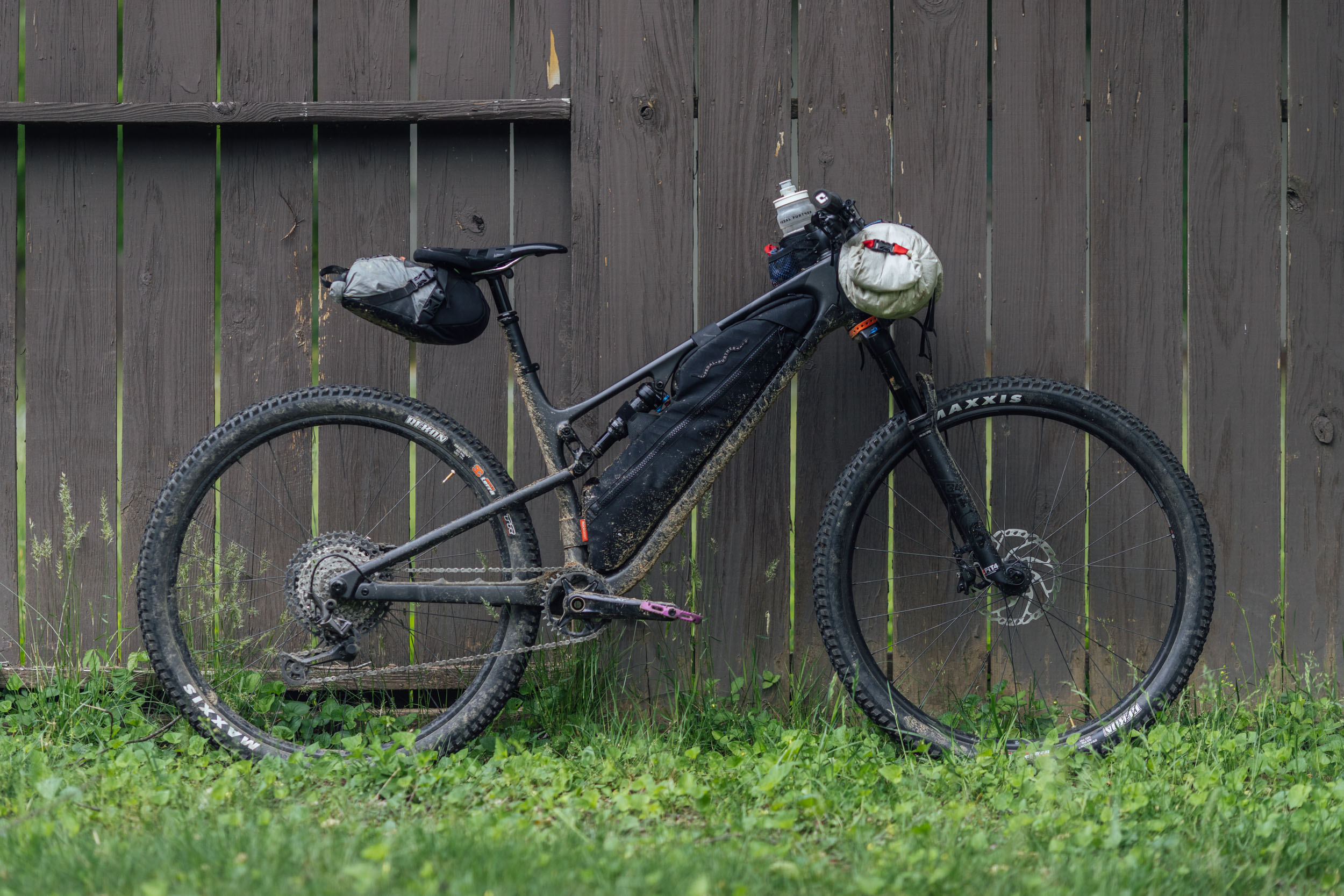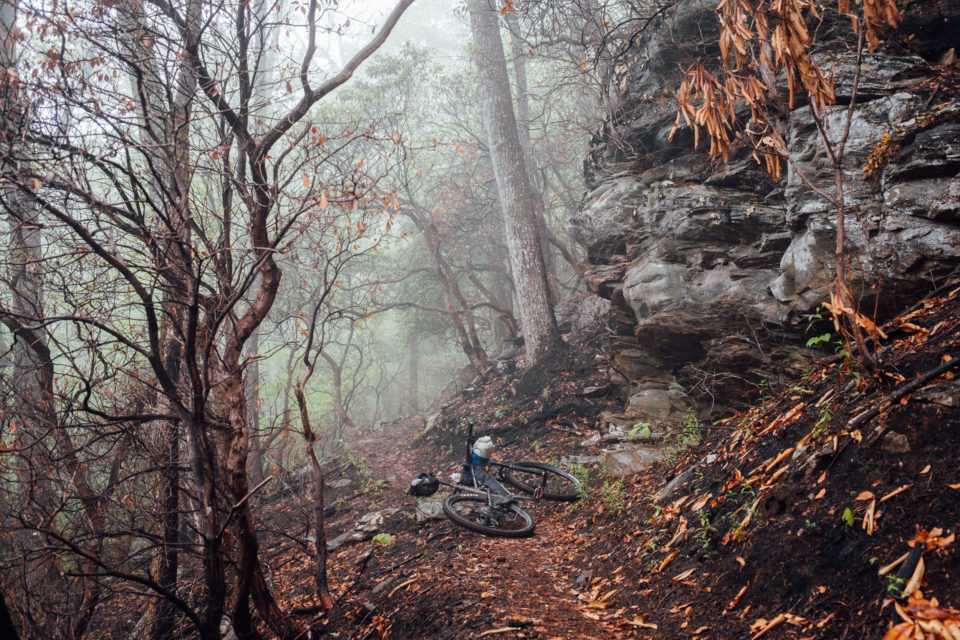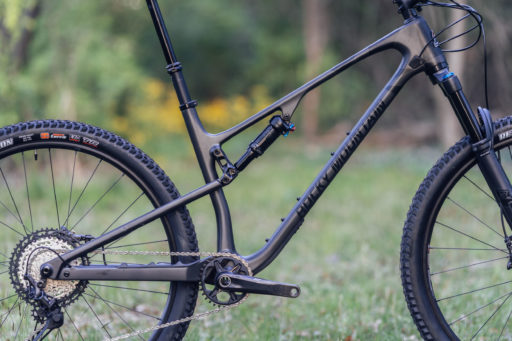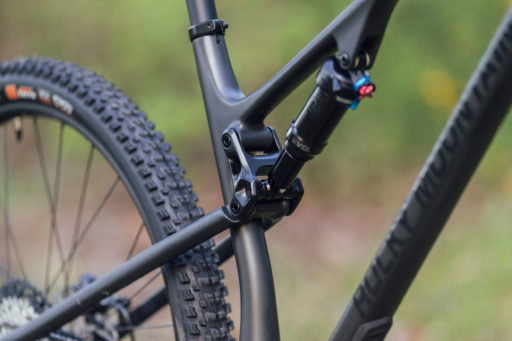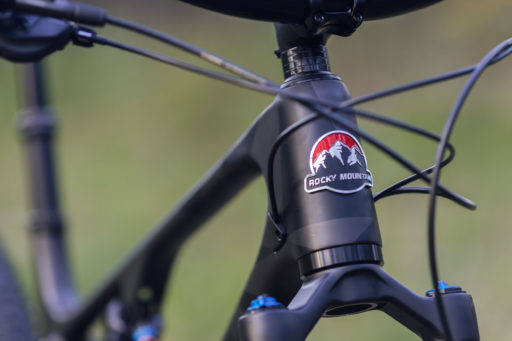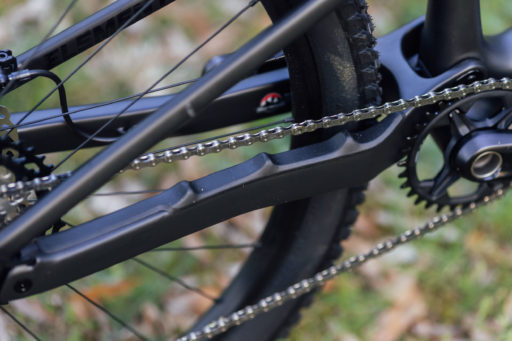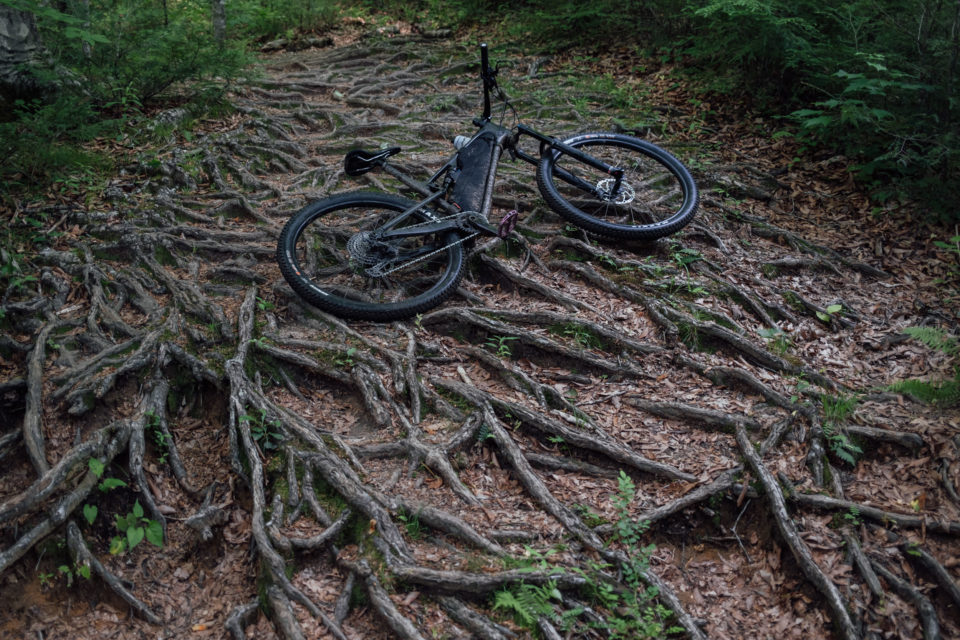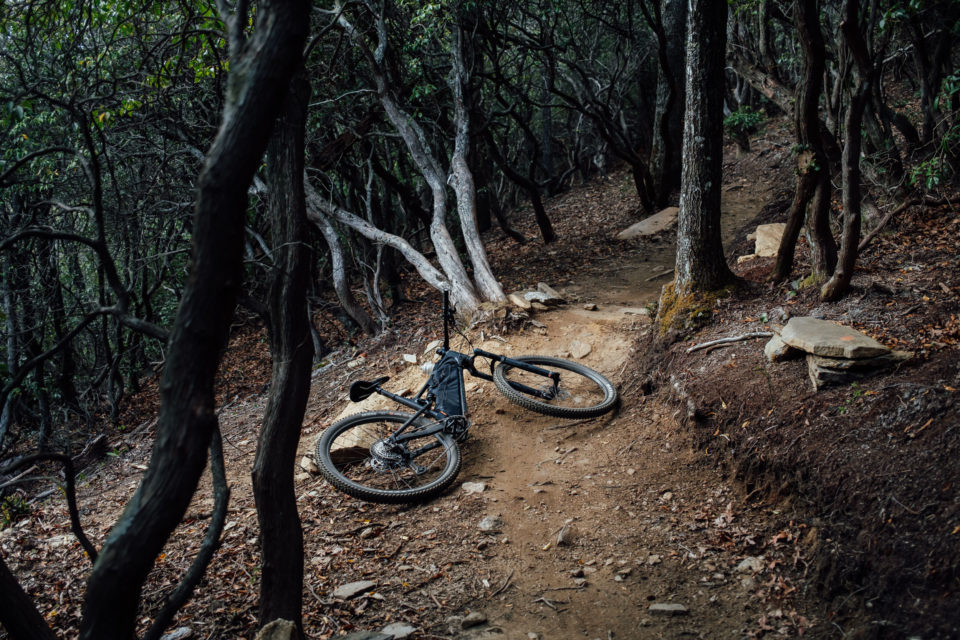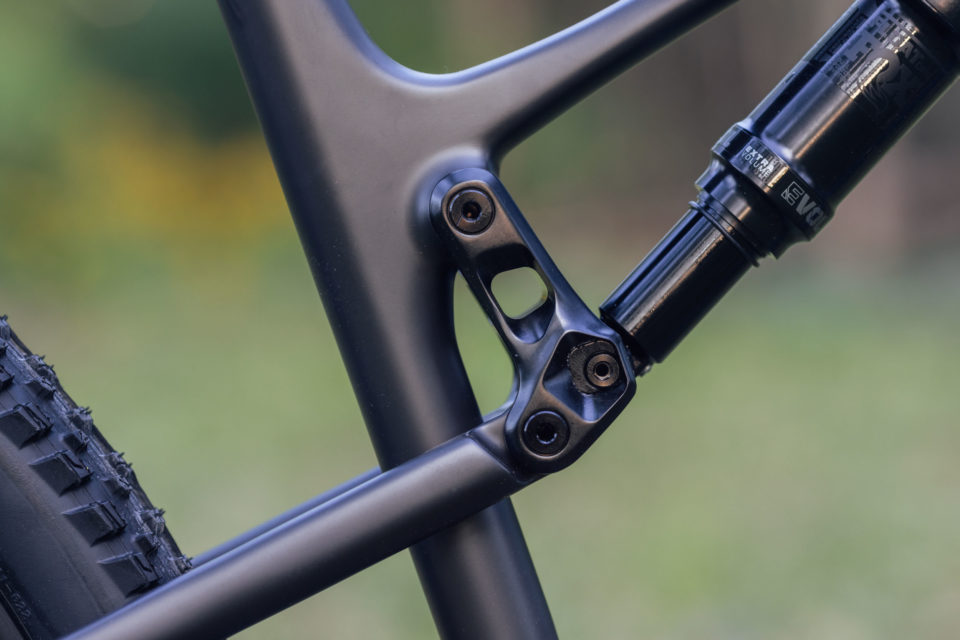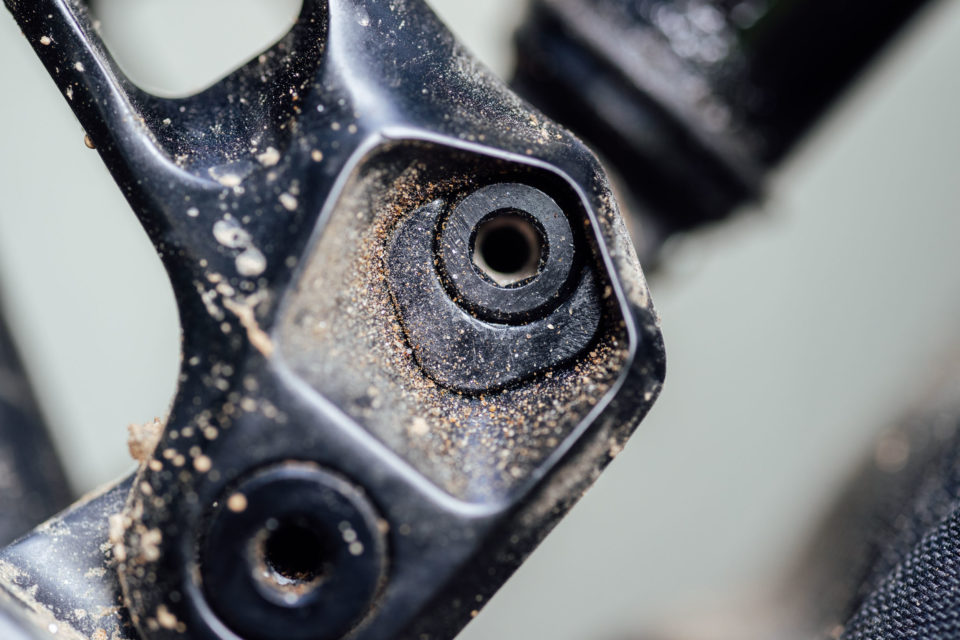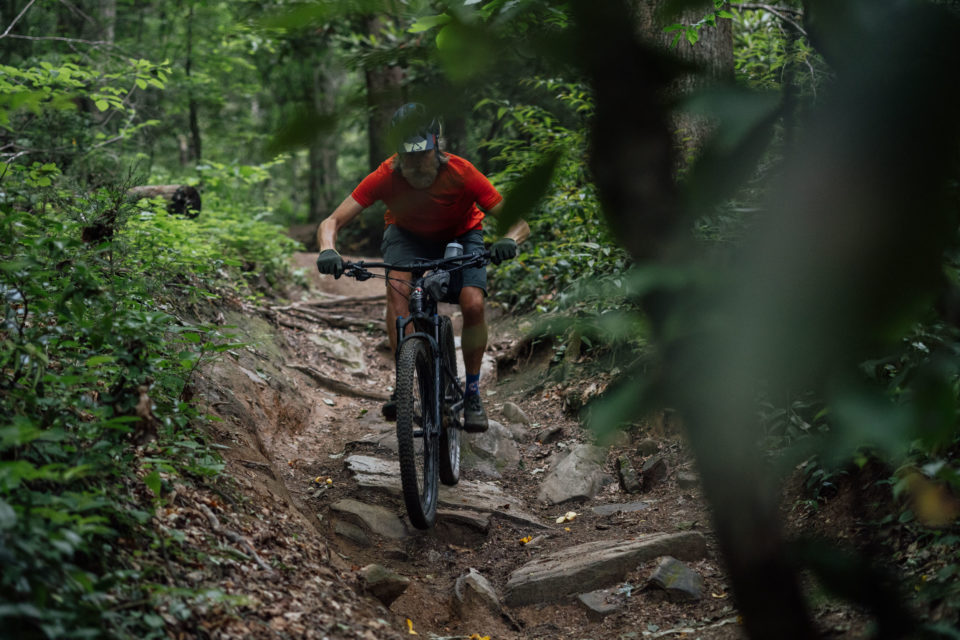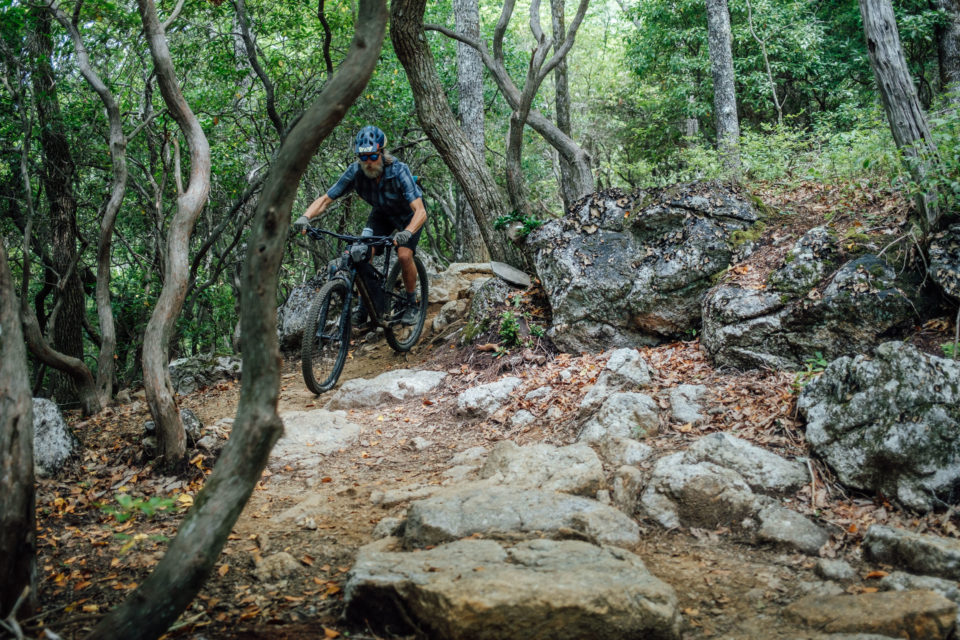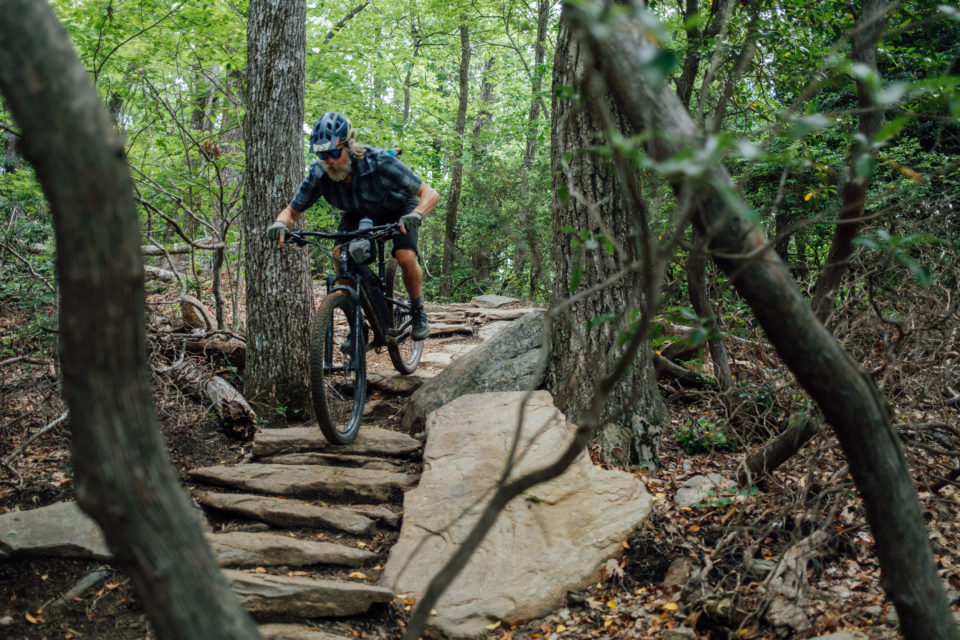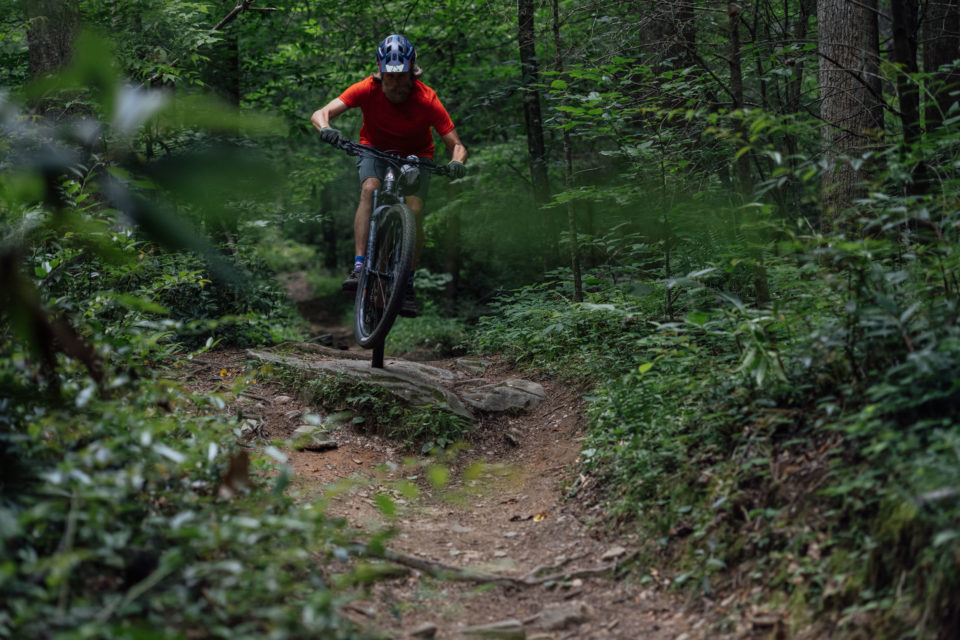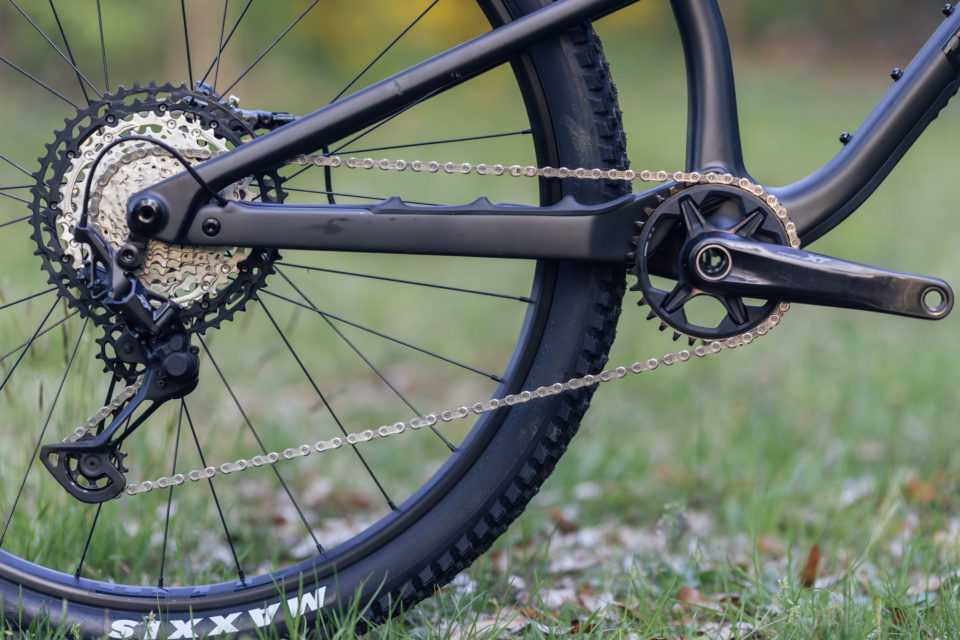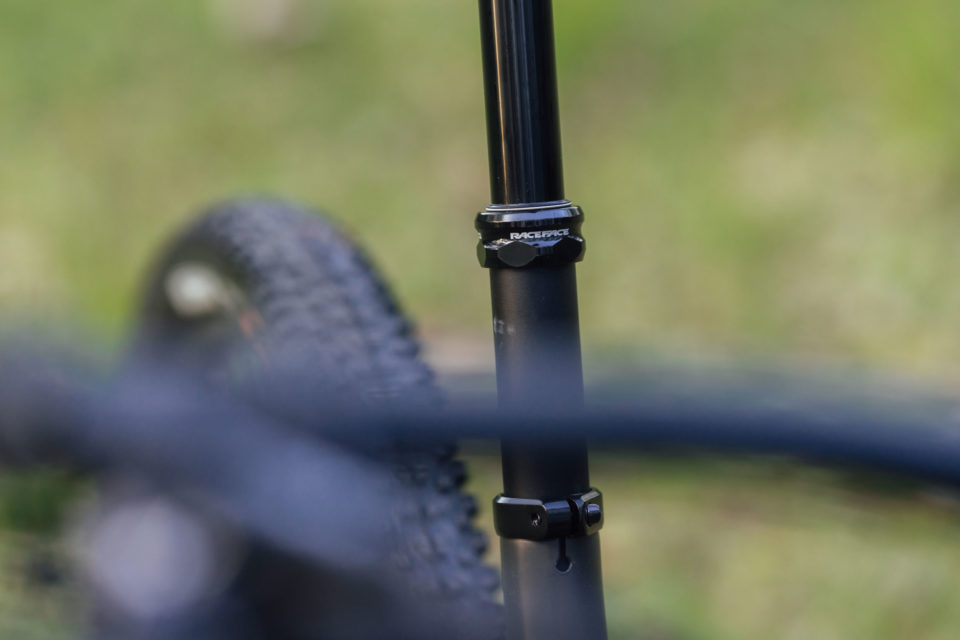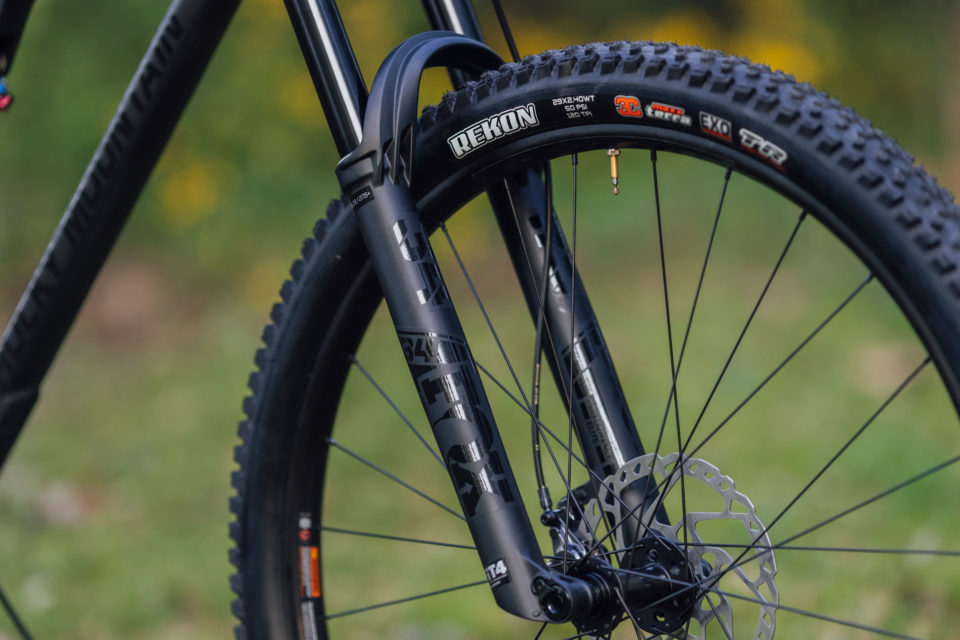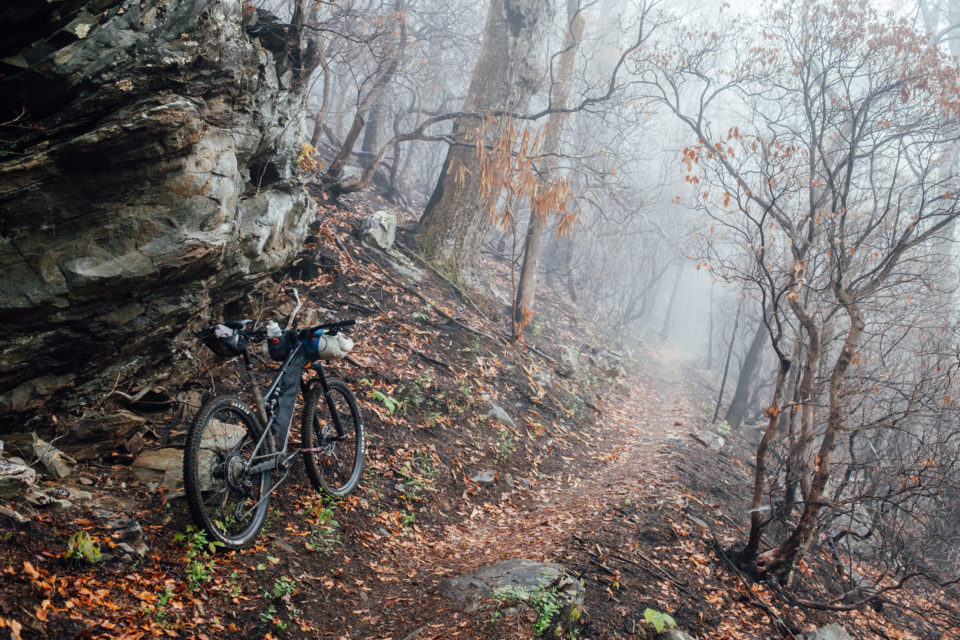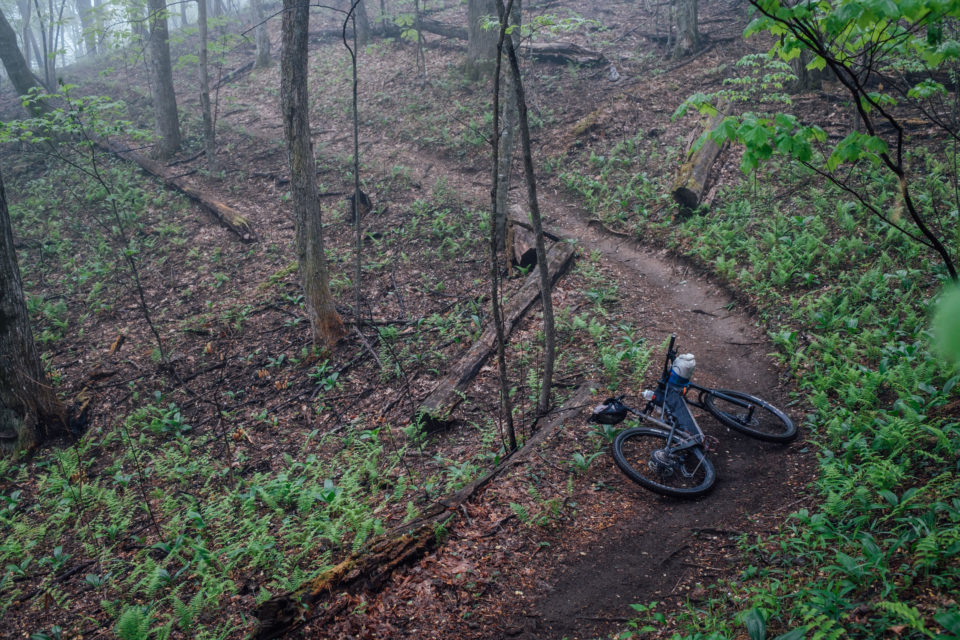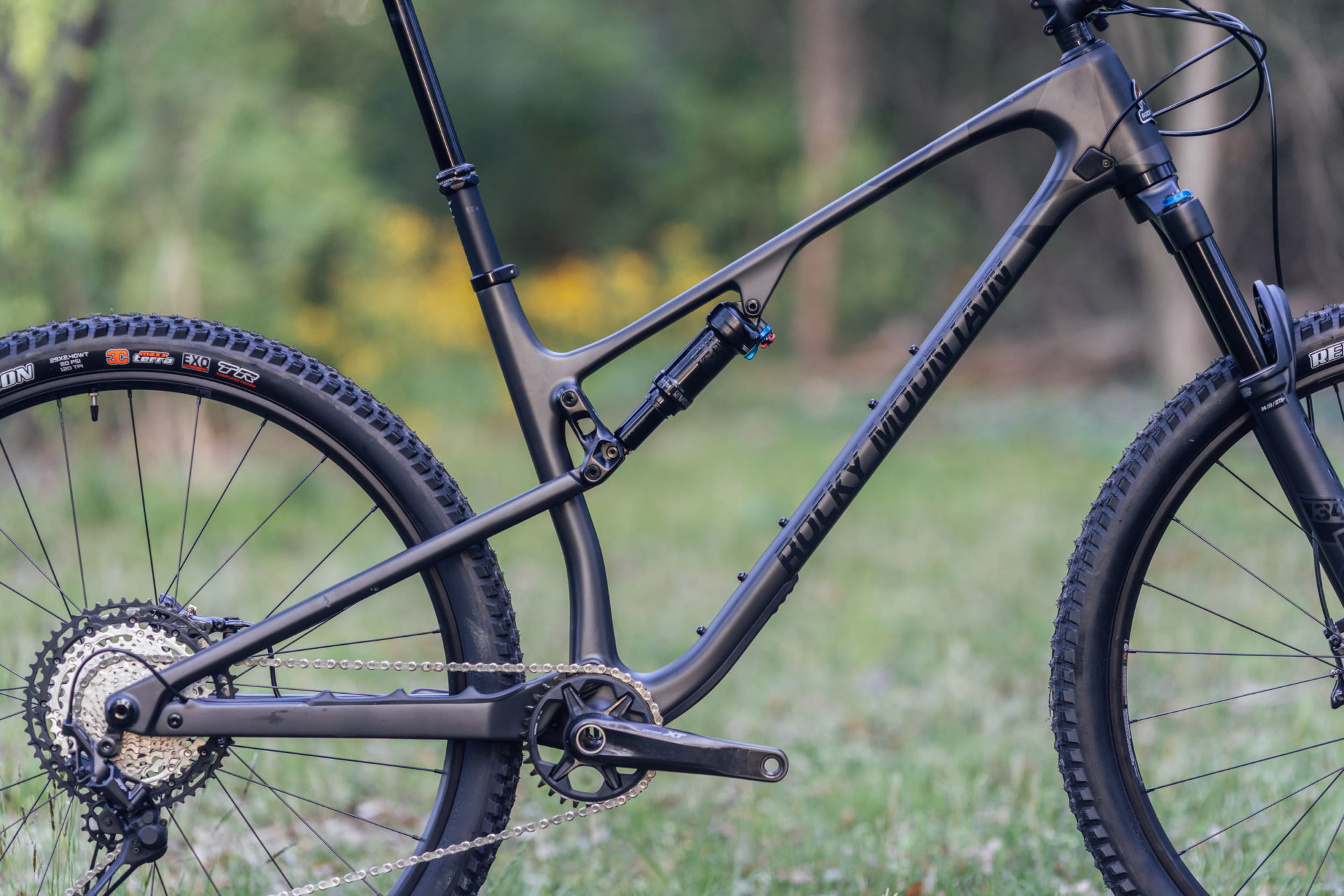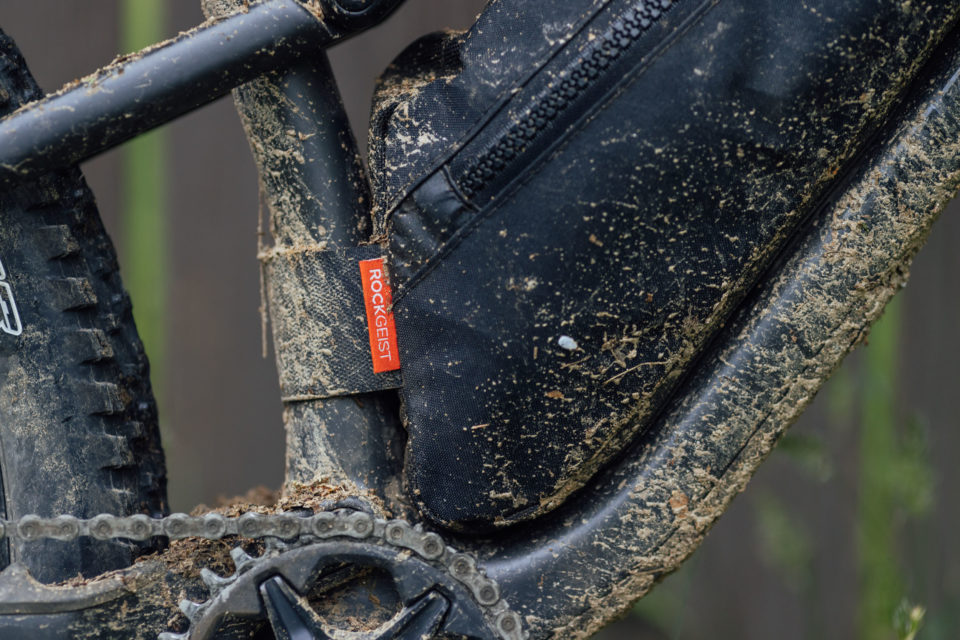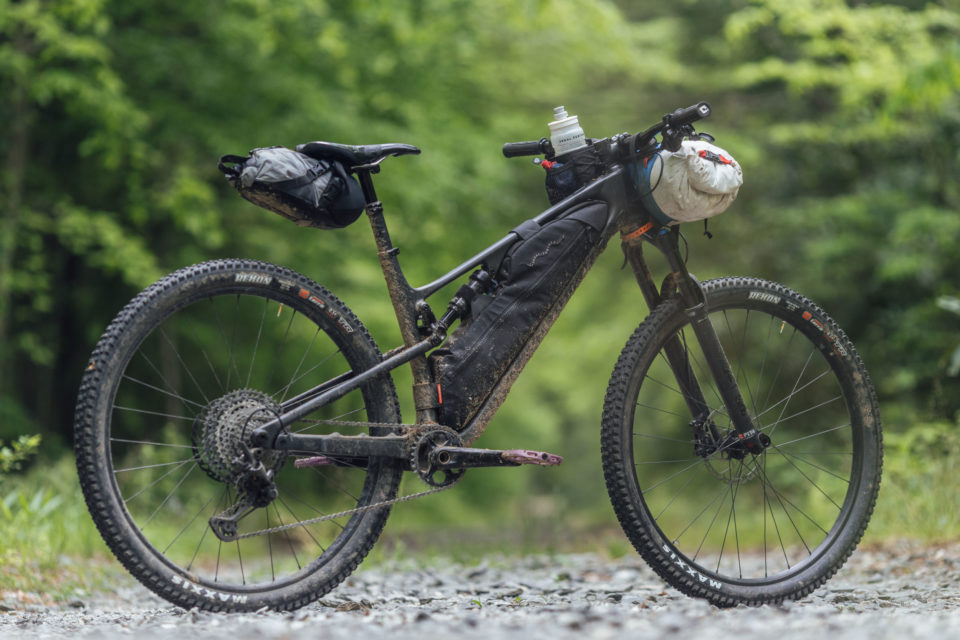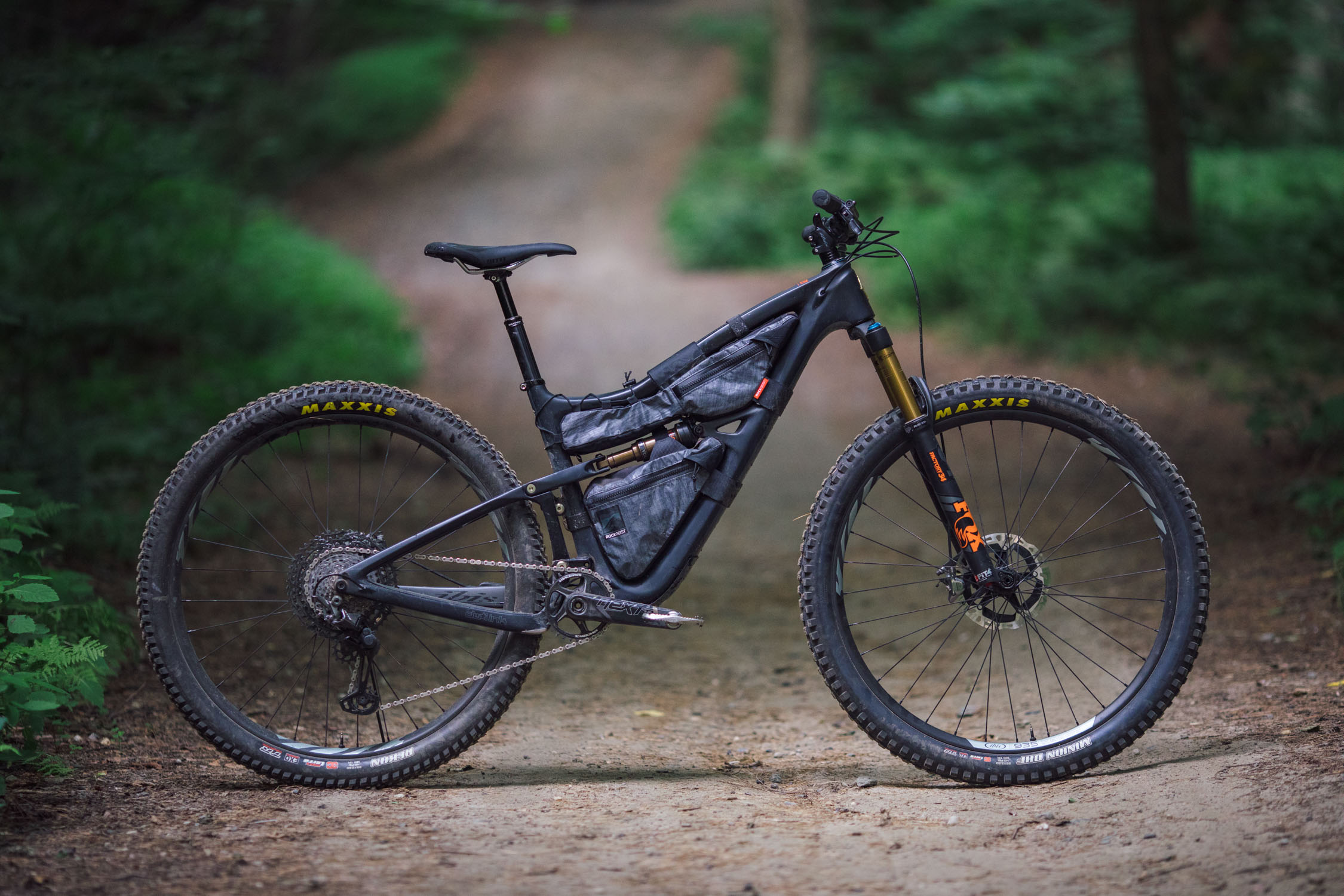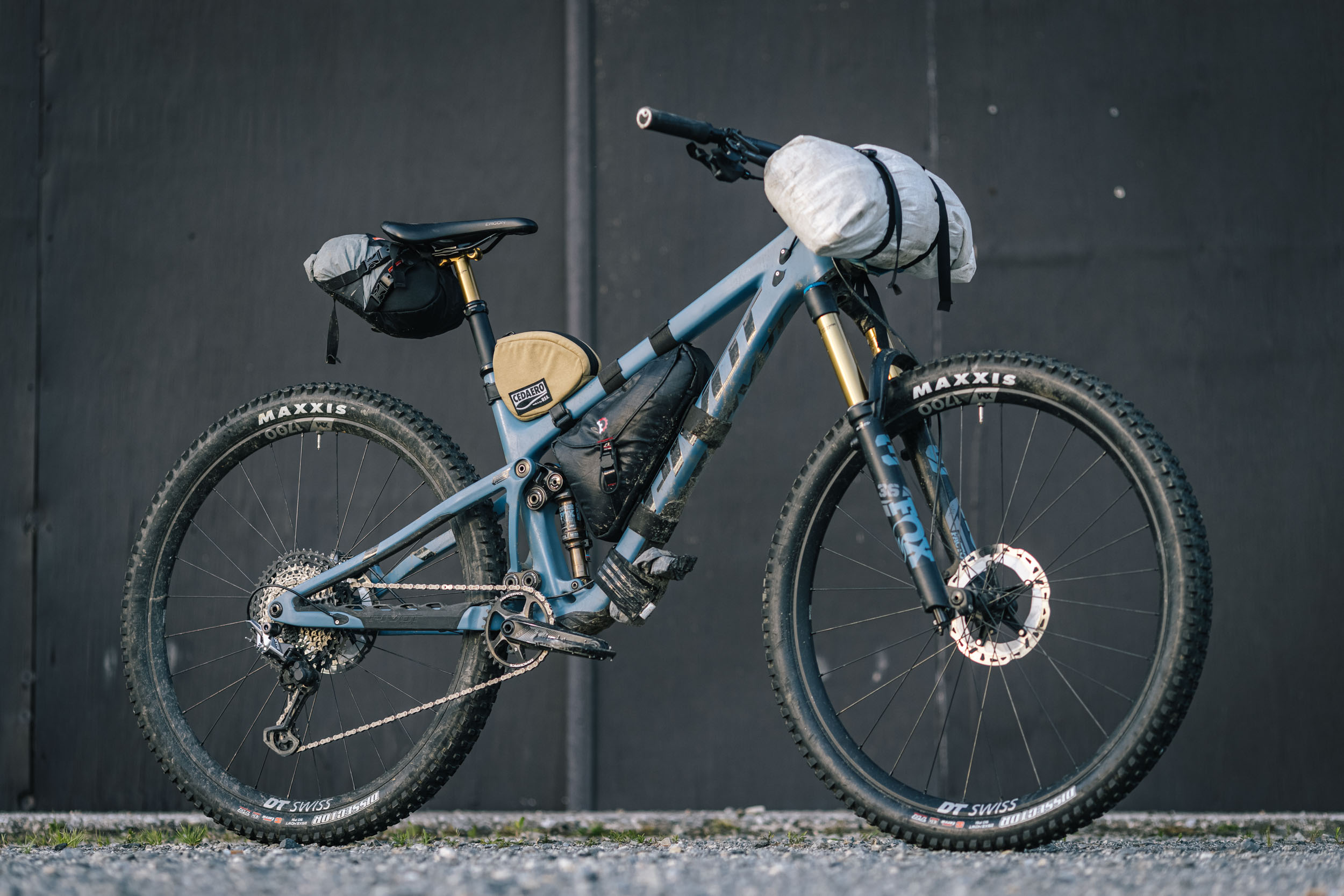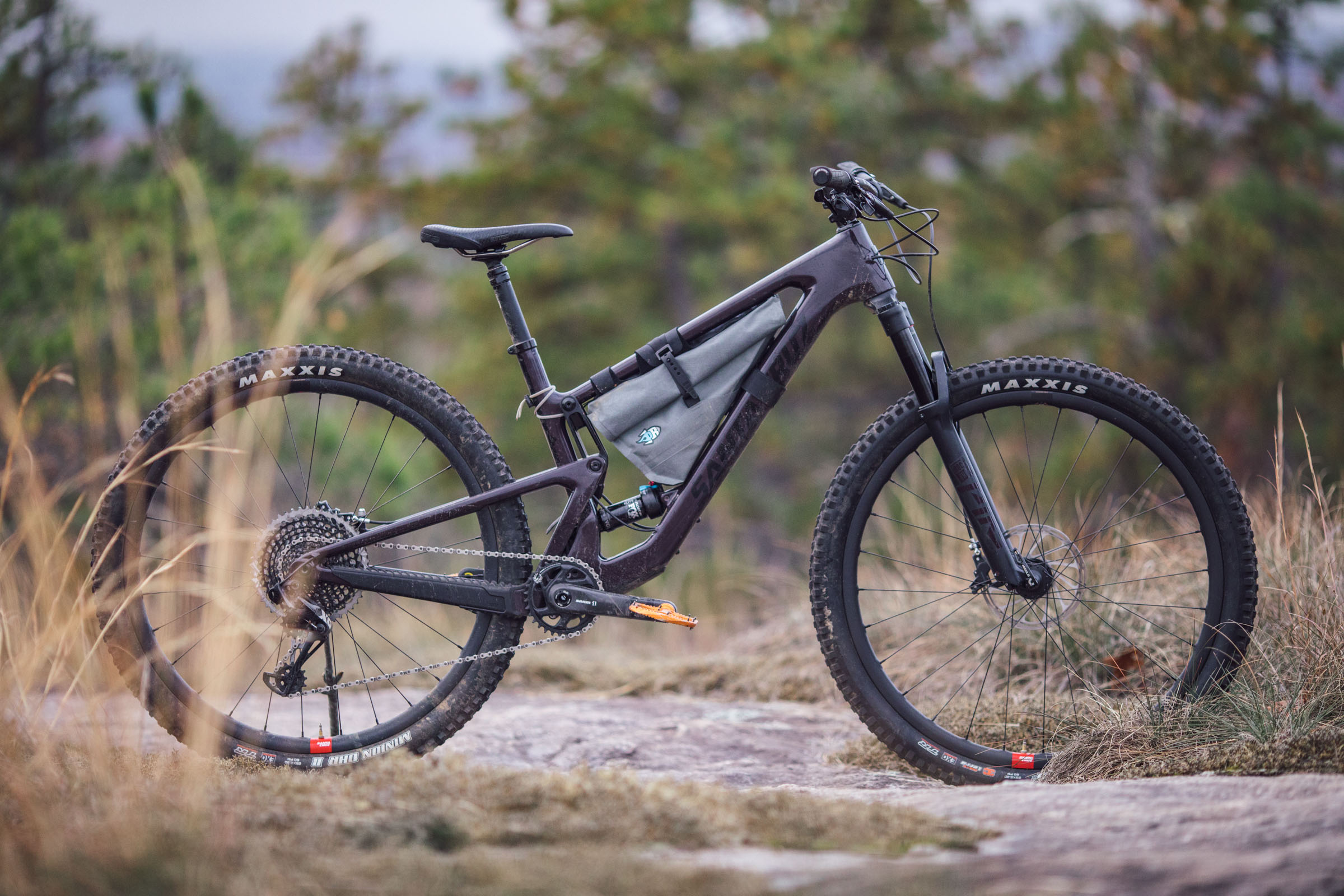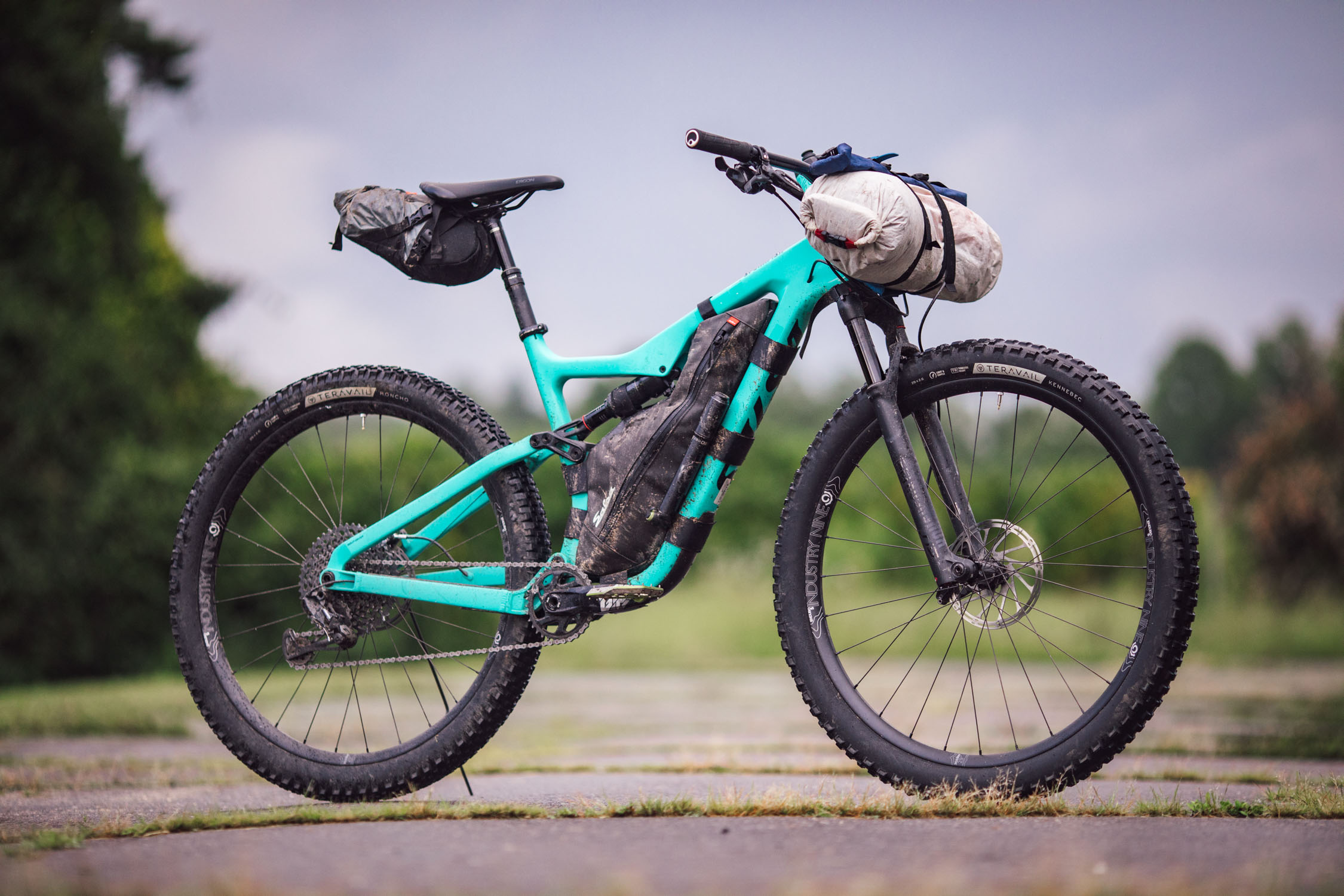2022 Rocky Mountain Element Review: Up, Down & Backcountry
Share This
The 2022 Rocky Mountain Element got a dramatic redesign, featuring more travel, a radical geometry change, and a massive frame triangle, complete with two sets of bottle mounts. It has a neat little trick up its sleeve, too. We had the chance to take one bikepacking and on a ton of trail rides for this review. Find all the details here…
Believe it or not, the Rocky Mountain Element has been the Canadian brand’s flagship cross-country mountain bike for around 25 years now. However, the prior-generation Element was ultra-conservative by today’s standards and was clearly made with spandex-clad, smooth-legged XC racers in mind. Rocky radically changed their tune this year and followed other short-travel 29ers down the elusive and logic-defying downcountry rabbit hole. In summary—and with all-too-familiar rhetoric—the 2022 Element was completely revamped to cross categories and become a lightweight short-travel 29er that’s capable of handling spicier trails and gnarlier terrain. And, you guessed it, Rocky Mountain claims that this was accomplished without sacrificing its primary XC characteristics.
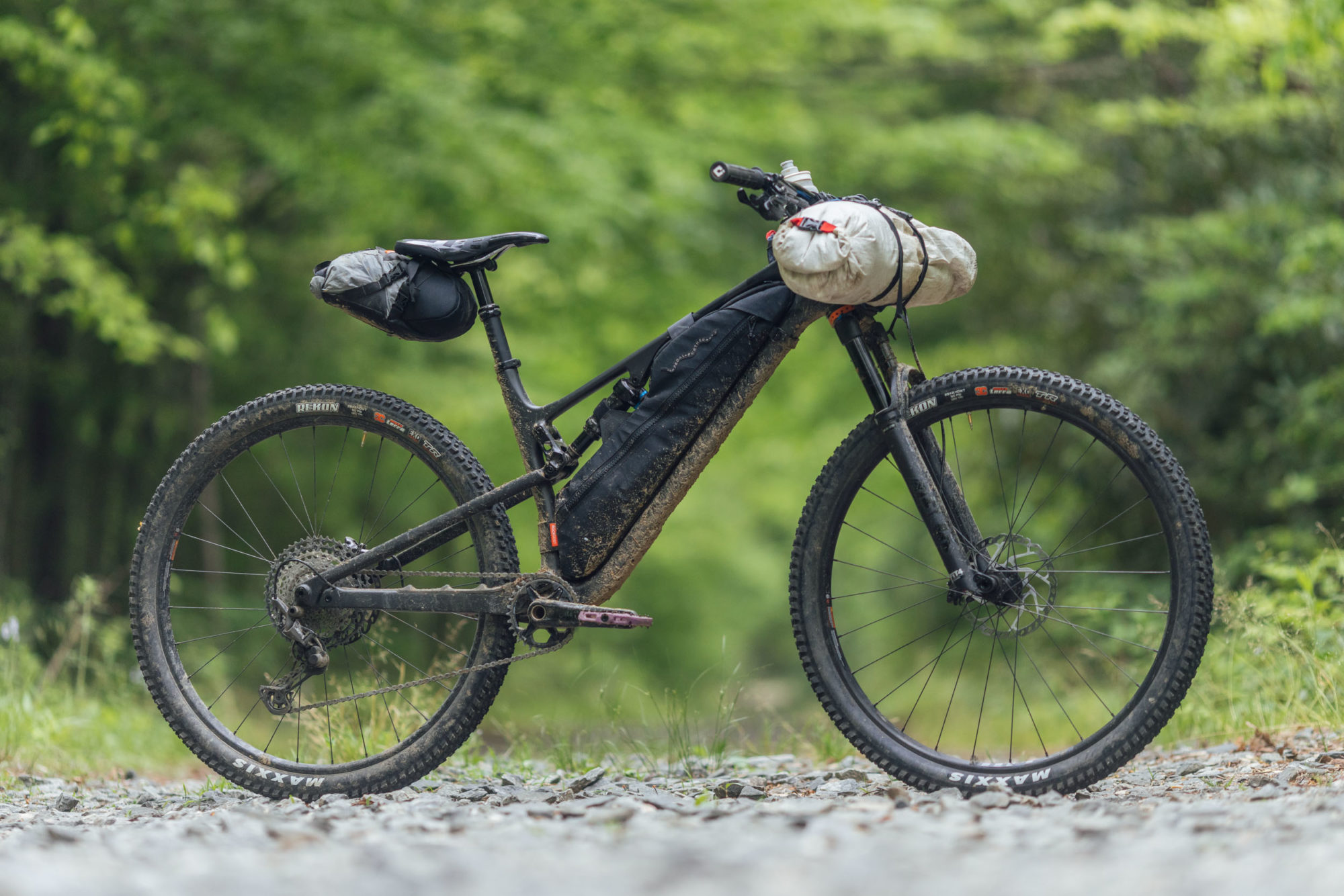
- Highlights
- Model: 2022 Rocky Mountain Element 70 (carbon)
- Angles (L): 65.5° Headtube, 76.5° Seattube
- Stack/Reach: 627mm/480mm
- BB Drop/Chainstay: 40mm/436mm
- Bottom Bracket: Press Fit (SM-BB71)
- Seatpost diameter: 30.9mmm
- Max tire size: 29 x 2.6″
- Price: $6,819 USD
To pull this off, Rocky Mountain increased the Element’s rear travel to 120mm and redesigned the platform around a 130mm fork. They also completely scrapped the old blueprint and reengineered the geometry from the ground up. Most notably, the 2022 Element’s head tube is a whopping 4.5° slacker than the previous generation, and the reach numbers across all sizes are substantially longer (up to 38mm on the XL). The seat tube angle has also been steepened to around 76.5° to compensate for the longer front end. And the wheelbase has been lengthened, too. This isn’t your standard yearly redesign. These are tremendous differences that transform the Element from a classic XC race bike into something far more progressive.
The Numbers Game
When compared with other bikes I’ve tested in this class—the Ibis Ripley, the latest Santa Cruz Tallboy, and the new Pivot Trail 429—the 2022 Rocky Mountain Element definitely falls in the aggressive side of the pack:
| Model | Element | Ripley | Tallboy | Trail 429 |
|---|---|---|---|---|
| Stack | 627 | 622 | 619 | 613 |
| Reach | 480 | 475 | 470 | 470 |
| Wheelbase | 1231 | 1207 | 1211 | 1205 |
| Head Tube Angle | 65.5° | 66.5° | 65.7° | 66° |
| Seat Tube Angle | 76.5° | 76° | 76.4° | 75° |
| BB Drop | 40 | — | 38 | 33 |
*All measurements in millimeters unless specified; WB=wheelbase; HTA=Head Tube Angle; STA=Seat Tube Angle
As you can see above, the Element doubled down on all the buzzwords, making it slacker, longer, and lower than the other three bikes. Further, that set of numbers is based on the four-position flip-chip set to the “neutral” position (POS.3 below), which means the Element can become even lower and slacker—0.5° slacker, to be exact.
As gimmicky and commonplace as flip-chips may be these days, Rocky’s implementation is pretty interesting. The “Ride-4” flip chip provides the ability to make geometry adjustments with a pair of four-position shock bolt inserts. As illustrated in the chart below, the inserts can be rotated to provide some pretty dramatic geometry changes. The difference between the “slack” and “steep” positions swings the angles by a whopping 0.8° and raises the BB drop by nearly a full centimeter.
| Ride-4 Chip Position | HTA | STA | BB |
|---|---|---|---|
| POS.1/Slack (lower-left) | 65° | 76° | 47mm |
| POS.2 (upper-left) | 65.2° | 76.2° | 43mm |
| POS.3/Neutral (lower-right) | 65.5° | 75.5° | 40mm |
| POS.4/Steep (upper-right) | 65.8° | 75.8° | 36mm |
To the Trails
Our demo 2022 Rocky Mountain Element came with the Ride-4 chip set to the neutral position, which is how I kept it for a while. My initial impressions were mixed. I rode some familiar backyard trails out of the gate and found the Element to feel a little clumsy when climbing. I love climbing, and I wasn’t happy to be missing and dabbing technical bits that I usually clear. I found myself having overthink balancing the bike and getting the front wheel up and over obstacles when things got slow and technical. I felt like I was a little off my game, which I believe was partly due to the sheer length of the bike. The Element also came across as a little sluggish on flatter terrain and while climbing. That was surprising considering it’s the lightest full-suspension bike I’ve ridden in a while. I wondered if this was a result of the thin carbon frame. It’s a beautiful frame that Rocky claims to have tuned specific to each size to help dampen trail chatter yet remain responsive while pedaling.
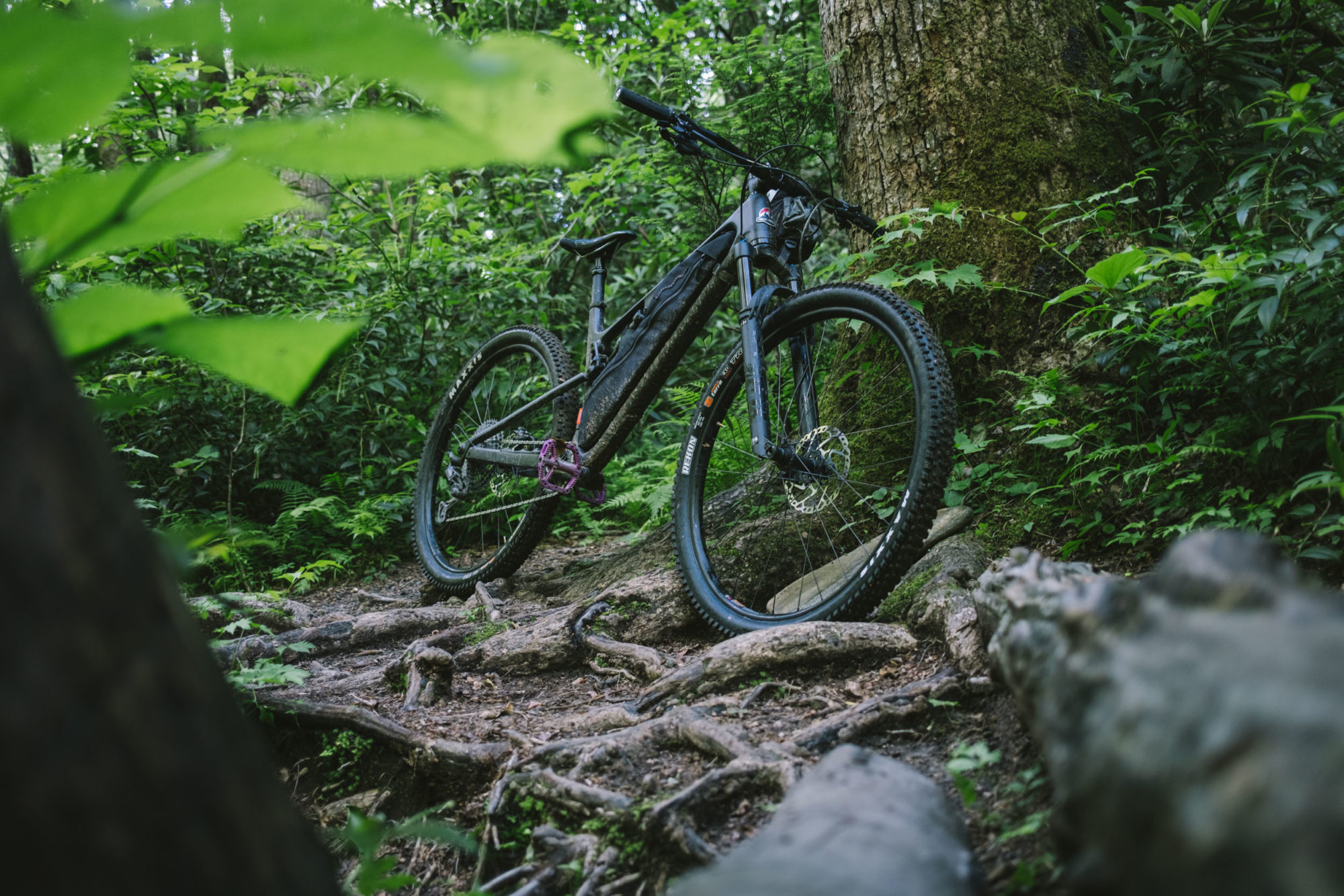
Fortunately, once the bike was pointed downhill, my sentiments shifted. The Element felt more confident, quick, and controlled than any of the previously mentioned 29ers, as if it was a bike in a “bigger” category. I’m pretty sure that if I used Strava, or cared about keeping score, I would have bested my times down several regular local downhills on the Element. It seems to eat up skull-rattling rocks and bumps better than other short-travel 29ers, which can probably be attributed to the bikes long front-center and slacker head tube angle. It’s also incredibly playful and I found myself attempting gaps and connecting bits of trail that I might otherwise ignore.
After a few more rides, I started to get used to climbing on the Element, adjusting my riding style to a more aggressive and forward stance. It generally felt quicker, too. However, it still felt slightly clumsy compared to my Ibis. Fine-tuning the pressure on the shock and fork helped some, but it still seemed a little bouncy at the rear end and awkward up front. I was also surprised that the cockpit felt somewhat short for me, especially considering that Rocky’s claimed reach measurement was longer than the other bikes mentioned. But again, it was so much fun on the descents that I kind of ignored it.
I decided to change the Ride-4 flip chip to the steep setting (above right) for a few rides in the latter part of my testing period to see how much it affected the bike’s handling. Surprisingly, the result was perceptible on both ends of the spectrum. Although I’d gotten used to it, the Element climbed noticeably better than it did when the chip was in the neutral setting. The move only tweaked the head tube angle by 0.3°, but it seemed to have better traction and feel a little more precise when negotiating steep, climby sections of trail. It’s still not as good of a climber as my Ibis, but I would maybe put it in the same class as the Tallboy in that regard.
I appreciated the slightly higher bottom bracket that the steep Ride-4 setting provides. I had previously surmised that folks could swap out 175mm arms for a shorter 170mm crankset to avoid pedal strikes, something I noticed on this bike. However, I later realized that it was already specced with 170mm cranks, which is slightly uncommon for a size large trail bike. The steep chip placement seemed to be a slight remedy.
Going downhill, the Element in steep mode felt a little less polished than it did when it was in the neutral setting. It just didn’t seem quite as playful and poised, at first. On the second and third rides in the steep setting I kind of forgot about it and still found myself having a blast connecting root gaps, making quick moves, and cornering. I’m guessing there was a bit of a placebo effect in play with both of these initial findings, and I should point out that I’m pretty impressed with the balance and capabilities of the Element, both in in steep and neutral modes.
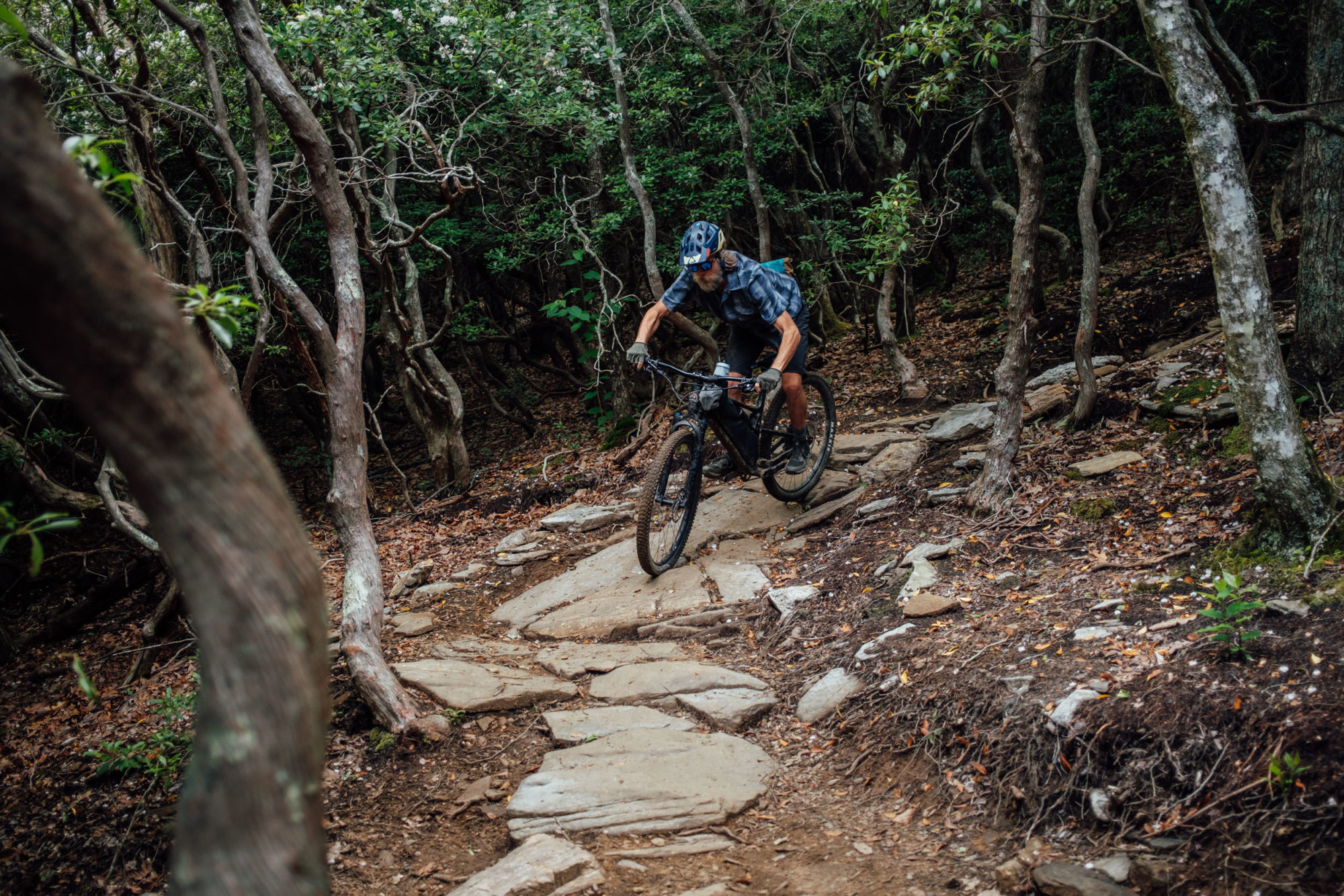
Build Kit
Complete builds range from $2,559 to $4,049 USD with an alloy frame, and from $4,259 to $9,589 USD for the carbon version. All models are based around wide-range 1×11 or 1×12 drivetrains, 130mm travel forks, and hydraulic brakes. The 2022 Rocky Mountain Element carbon frameset is also available for $3,199. Rocky sent us the carbon Element 70 build for review. Here’s the full build kit, followed by some thoughts on its value and performance:
- Fork: Fox 34 Float Performance Elite 130mm, FIT4 Damper, 44mm Offset
- Shock: Fox Float DPS Performance Elite, Sealed Bearing Eyelet, 190x45mm
- Headset: FSA Orbit NO.57E, 36×45° Bearings, 30.2x41x7.1mm Upper, 40×51.8×7.5mm Lower
- Stem: Rocky Mountain 35 XC, 5° Rise, 50mm
- Handlebar: 35mm Rocky Mountain AM, 760mm Width, 25mm Rise, 9° Backsweep, 5° Upsweep
- Grips: ODI Elite Pro Lock On
- Brakes: Shimano XT 2 Piston, Metal Pads
- Rotors (F/R): Shimano RT66 180mm
- Shifters: Shimano XT
- Rear Derailleur: Shimano XT
- Cranks & Chainring: Shimano XT, 32T, 24mm Spindle, 170mm
- Bottom Bracket: Shimano SM-BB71
- Cassette: Shimano XT 10-51T
- Chain: Shimano M8100
- Front Hub: Rocky Mountain Sealed Boost 15mm
- Rear Hub: Race Face Trace Boost 148mm, 10° Engagement
- Spokes: DT Swiss Competition 2.0/1.8/2.0
- Rims: WTB ST Light i27 TCS 2.0 Tubeless, 28H, Tubeless Ready
- Front Tire: Maxxis Rekon WT 3C MaxxTerra EXO Tubeless Ready 2.4
- Rear Tire: Maxxis Rekon WT 3C MaxxTerra EXO Tubeless Ready 2.4
- Seatpost: Race Face Turbine R (by Fox) Dropper 30.9mm, 175mm
- Saddle: WTB Silverado Race 142
Honestly, considering the roster of components on the 70, $6,819 isn’t that mind-numbing in the grand scheme of mountain bike pricing these days. It has a solid XT drivetrain, a Fox 34 Float Performance Elite fork, a reliable Fox-built Race Face Transfer dropper, and might be the lightest full-squish complete I’ve ridden in a while. It weighed 27.49 pounds (12.47 kg) on my scale after I set it up tubeless.
All that being said, this build isn’t without a curious set of shortcomings. For one, it didn’t come set up tubeless, which was disappointing in this day and age. Also, considering this bike’s trail prowess, I have no idea why Rocky specs it with a 760mm handlebar (note that mine came with a 780mm bar, despite its published specs) and two-piston brakes. I think 800mm should be the standard bar width for a size large bike of this caliber. And while I like XT brakes, the four-piston versions don’t have nearly enough stopping power. The four-piston versions are far superior. Additionally, why would a Pacific Northwest company use a Maxxis Rekon as a front tire? It’s fine for tacky XC trails, but this bike should have a more aggressive DHF or DHR up front. The wheelset is okay, although I’d like to see the faster Vault hub vs. the slow 10-degree Trace. It’s an entirely decent build kit, as a sum of its parts, but perhaps those few odd choices were the result of the supply chain squeeze?
Lastly, the 2022 Rocky Mountain Element has a Press Fit bottom bracket. For a while, I wasn’t too critical of PF standards, but now that a lot of companies have started rolling back their carbon frames to use standard threaded BBs, it’s a hard grouse to ignore. To that end, it’s worth noting that it started creaking a couple of miles into the test period.

While Out Bikepacking
Back when it was announced in fall 2021, I really liked all of the changes Rocky Mountain made to the Element on paper, but one of the main reasons I was interested in checking it out was its massive frame triangle. In my eyes, Rocky solved something with this bike that many other brands seemed to ignore with bikes in this category: Rocky retained the ability to run a long dropper and still provided a huge frame cavity fit for a large frame bag or two full-sized water bottles. I remember thinking to myself that if all the geometry figures added up, this may well be the ideal full-suspension bikepacking rig.

I’m happy to report that this premonition came true—kind of. The Element is a great backcountry bikepacking bike, as it turns out. Once loaded down with a solo bikepacking kit, it seemed to tame some of the clumsiness I felt with the bike’s handling on climbs. It also felt pretty fast, thanks in part to the lightweight build. Best of all, the times I rode it loaded were with the Ride-4 chip in the “neutral” position before I changed it over to try and solve fit and climbing issues on the trail. Loaded up, it handled technical climby bits well and still maintained that ultra-confident flowy and nimble feeling when descending. I’ve found that it’s pretty common for trail bikes to feel even more sure-footed when loaded, but the Element seemed to really come alive with the added weight.
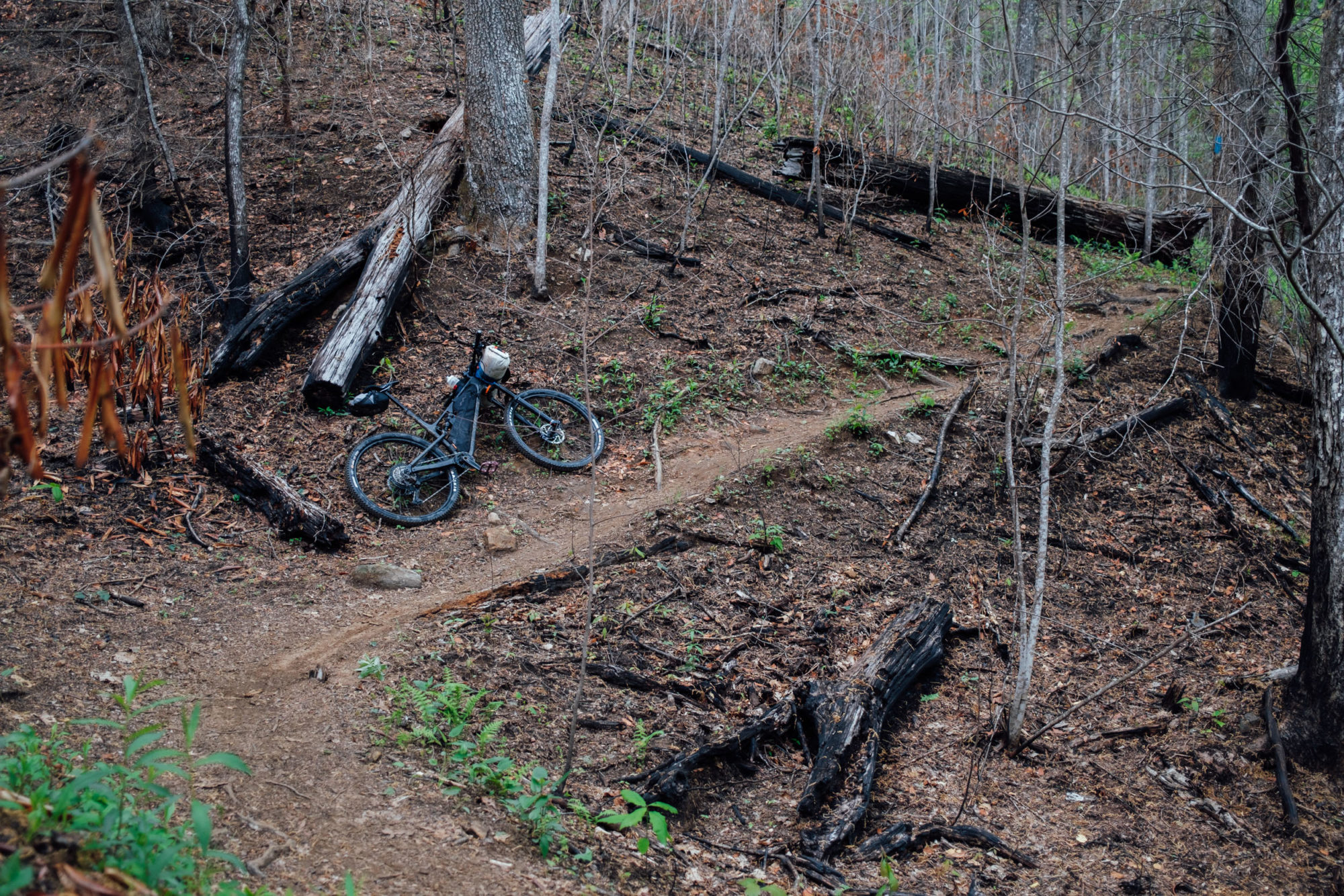
The frame bag space was equally as impressive. This excellent custom bolt-on frame bag was made by local bagmaker Rockgeist from their new recycled X-Pac material that’s manufactured in North Carolina. The bag itself is about the size of a full-frame bag on a size medium bike. I was able to fit my cook kit, tools, pump, a couple of meals, snacks, and a 16oz can of beer.
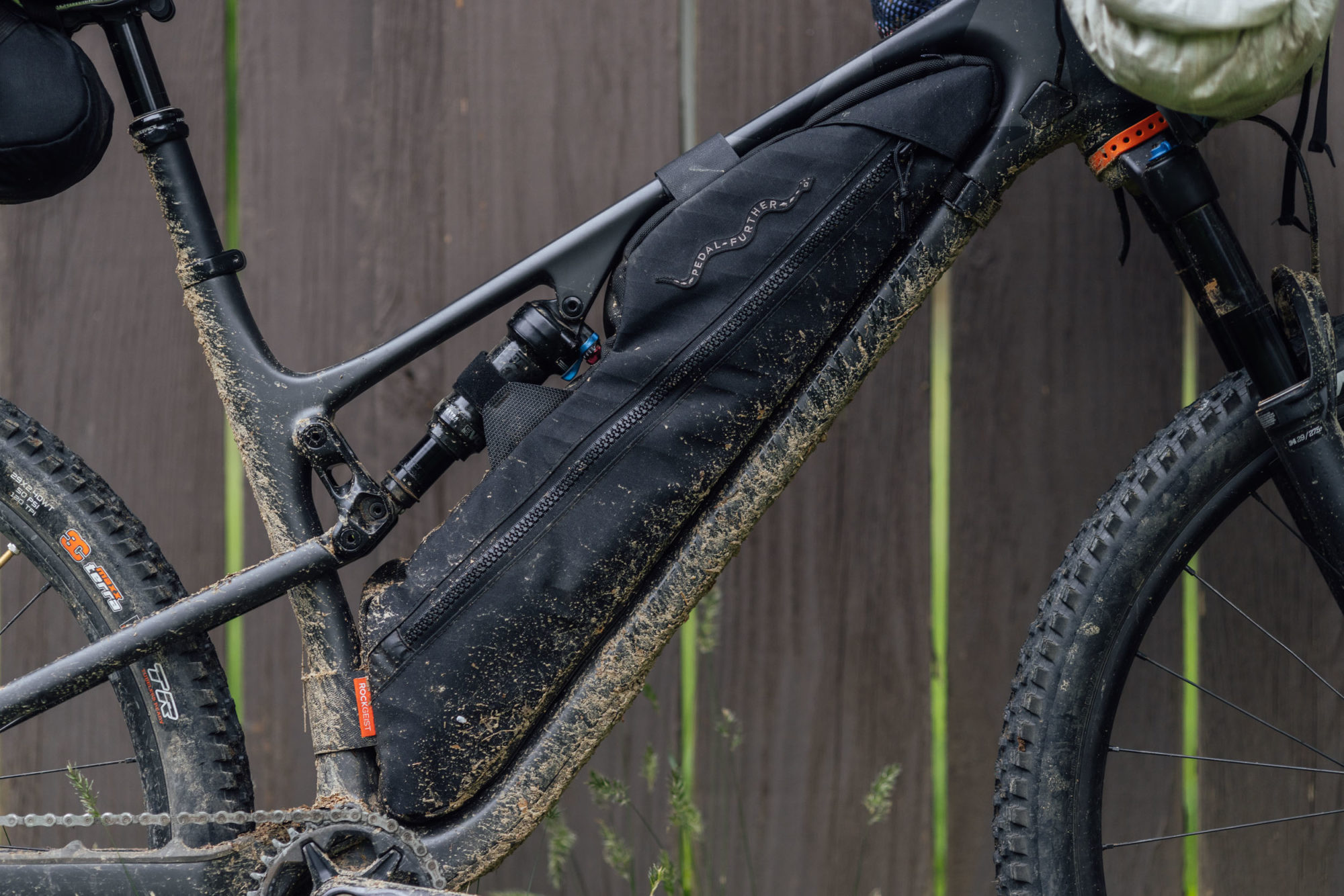
Lastly, one hidden perk with the new Rocky Mountain Element frame comes from that slim bit of top tube just above the rear shock. I noticed this while riding a couple of trails that have several creek fords and log bridges. Usually, you have to shoulder your bike at these crossings, but that little bit of tubing makes the perfect portage handle. Of course, it helps that the Element 70 is super lightweight.
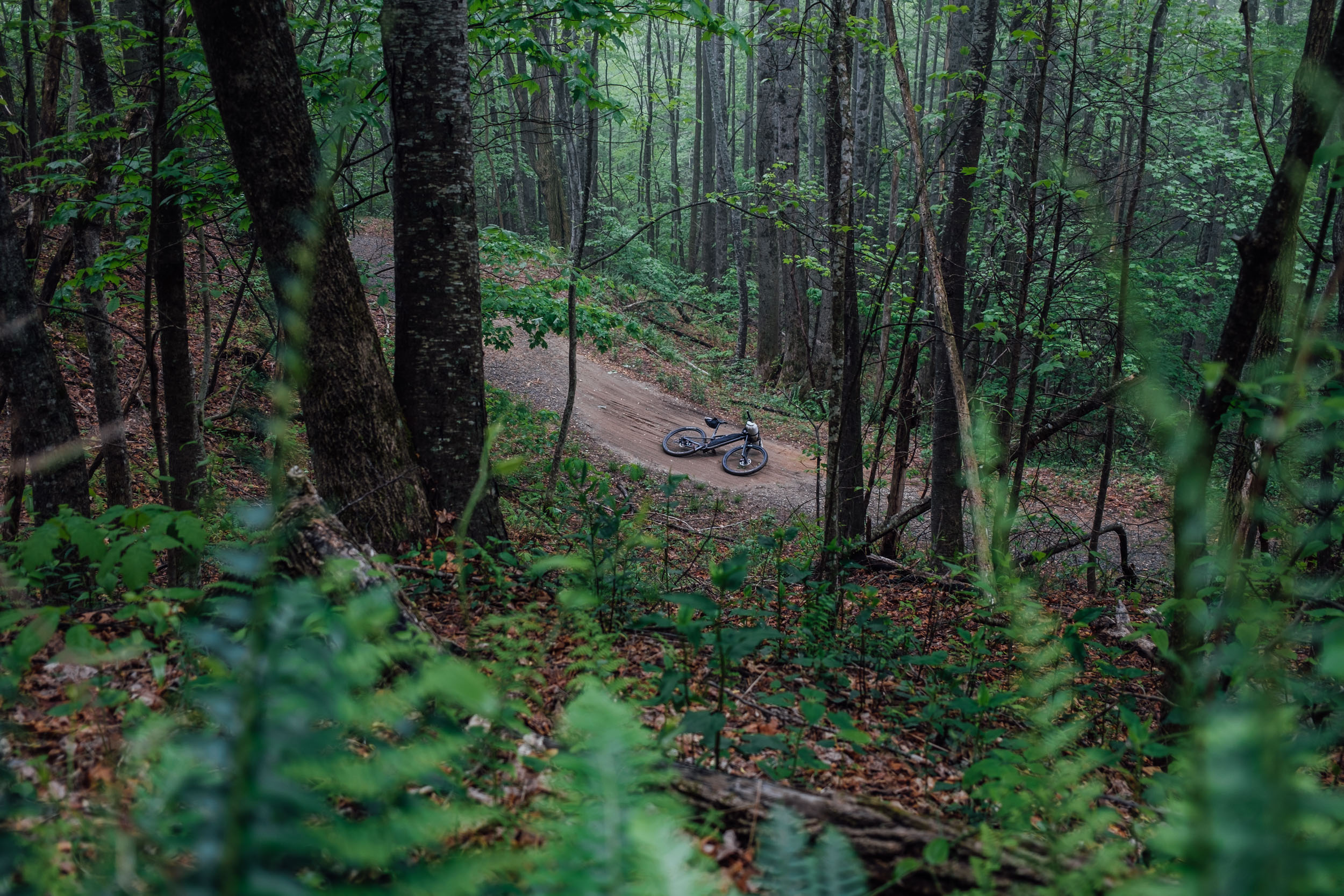
- Model/Size Tested: Rocky Mountain Element 70
- Actual Weight: 27.49 pounds (12.47 kg)
- Place of Manufacture: Taiwan
- Price: $6,819
- Manufacturer’s Details: Bikes.com
Pros
- Well-engineered Ride-4 flip chip offers perceptible shifts to dial in the geometry (and fit) to your liking
- Massive frame triangle space is great for a big frame bag or two bottles and doesn’t sacrifice dropper post space
- The bike handles and descends well beyond its XC category
- XT build isn’t overly expensive (compared to other bikes in this class)
- Ridiculously lightweight for a bike of this caliber
- Rides really well when loaded with a minimal bikepacking kit
Cons
- The Element is kind of a clumsy climber, even when Ride-4 chip is in the neutral position, but it gets better in the steep position
- It also doesn’t feel as fast as one would expect on rolling terrain or while climbing
- Build kit has a few poorly picked components, including one-piston brakes, a handlebar that’s too narrow, and an odd front tire
- Press Fit bottom bracket began creaking after a couple hundred miles of use; it came and went depending on temperature
Wrap Up
To wrap up my 2022 Rocky Mountain Element review, I’ll try to paint a picture of exactly who this bike is for. Rocky took a giant leap outside its historical XC target with this iteration, which might leave longtime fans of this platform scratching their heads. I’m pretty sure the Element is no longer a bike built for someone looking to make the podium at XC races. Instead, it might be a great bike for folks whose work-to-play ratio is more in line with backcountry riding or more progressive trail riders looking for a more efficient bike for long rides.
To that end, the new Element is a bike you can pedal all day but still rally down challenging terrain, clearing lines you might otherwise back away from, all the while having a blast. The Ride-4 chip, lightweight build, and massive frame triangle also back up its positioning as an excellent backcountry bike. And if you can get over the PF bottom bracket and a couple of part spec complaints, it makes a superb bikepacking rig.
As I was boxing up the Element to send it back, I looked up at my Ibis Ripley, which has been patiently hanging in the rafters while I was testing the Element. I found myself thinking about installing a Wolf Tooth Geoshift headset on it to slacken the head tube angle and make it longer. I suppose that’s the impression the Element left. It was a lot of fun railing down my local trails with a speed and grace that seems a cut above and beyond what’s attainable with the other short-travel 29ers I’ve tried.
More Full-suspension Bike Reviews
Here are a few reviews of the bikes we used for comparison in the 2022 Rocky Mountain Element review...
Please keep the conversation civil, constructive, and inclusive, or your comment will be removed.






